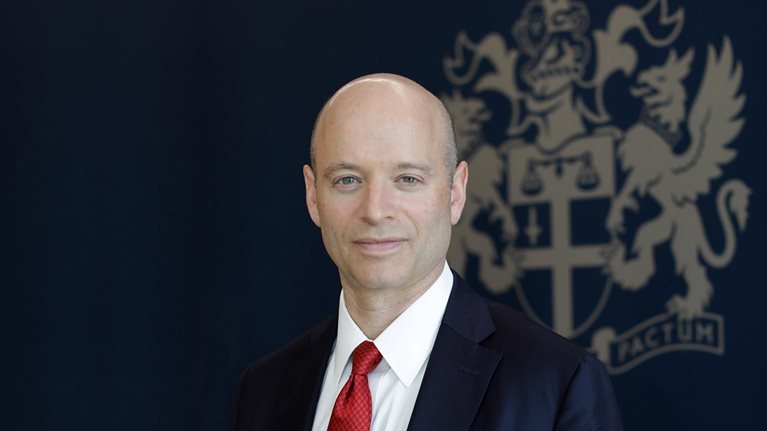From disrupter to incumbent and back—that’s been the 50-year journey of the Nasdaq (also known by its more formal name, the National Association of Securities Dealers Automated Quotation system). It was the first electronic market exchange when it launched in February 1971; it later established itself as the listing home of technology lions such as Apple and Microsoft; and now, Nasdaq itself is a provider of market technologies, such as data and analytics services, for other exchanges worldwide.
In an interview with McKinsey’s Vijay D’Silva and Roberta Fusaro, Nasdaq president and CEO Adena Friedman explains where the company has been in its first five decades and where it’s going—specifically, how it’s pursuing growth and innovation, how it manages its role as both user and provider of data, and how it’s thinking about environmental, social, and governance (ESG) issues, all while remaining relevant to investors worldwide.
The Quarterly: Nasdaq turns 50 on February 8, 2021. How have the markets and the company changed over the past five decades?
Adena Friedman: When Nasdaq started back in 1971, we were the disrupter of our time. We were using the most modern technology to democratize the capital markets, which, back then, were “physical”—based on having a lot of people in a specific room. By contrast, we launched a networked exchange that was available to anyone anywhere in the US. In 1971, our first listings were Applied Materials, Comcast, Intel—companies that are now, of course, staples in the US economy, but back then, they were still just ushering the country into the technology age. In the 1980s, Microsoft and Apple listed on Nasdaq. And in the 1990s, we coined the phrase, “Nasdaq, the stock market for the next 100 years.” That’s when I joined the company, in 1993, and we started to think about how we could help drive the future of the economy. The market model was still shifting, and it wasn’t until online retail brokers were born, in the later 1990s, that capital markets really became democratized. Millions of investors were starting to be able to access the markets directly. Today, it’s tens of millions, if not hundreds of millions, of retail investors coming in and trading every day. We were struggling to get to 500 million shares a day back then; now we’re at ten billion to 15 billion shares a day [exhibit].

About 15 years ago, we started advancing ourselves beyond the equities markets. We are now among the largest options markets in the US, and we own many of the Nordic markets in Europe. We also sell our technology to other exchanges, market operators, and broker–dealers around the world. We have a data and analytics business that’s been scaled for the investment community. It’s been an interesting journey. Obviously, there’s been a big shift in the breadth and depth, electronification, and globalization of the markets.
The Quarterly: To your point about globalization, can you talk about the trends in capital raising across borders?
Adena Friedman: Companies worldwide are looking to tap public markets and public investors here in the US. Why do they choose to come to the US when they have vibrant markets in their own countries? One obvious reason is the breadth and depth of the investor base in the United States; it’s the most diversified of any market in the world. US capital markets bring together retail investors, institutional investors, pension funds, and hedge funds. That whole mix creates more liquid markets, tighter spreads, and better execution for investors. If you’re, say, a biotech company, knowing that you’re coming in and tapping an investor base that really understands your sector will give you every opportunity to maximize your value.
The Quarterly: You’ve talked about the concept of “markets everywhere”—the fact that markets can play a role in all sectors of the economy. What are the benefits of that approach?
Adena Friedman: Nasdaq is a platform by which participants can come in and establish prices for goods and services on an ongoing and, in many cases, real-time basis. We spend a lot of time thinking about how to apply the core elements of the market economy—that is, this two-sided price formation that gives both buyers and sellers a voice—outside of securities markets, stocks and bonds, and futures and commodities. Recently, we’ve been working with companies that want to bring market principles to other parts of the economy. Specifically, we provide technologies and partner with about 130 other organizations across the world, supporting traditional exchanges but also new and exciting ones. The airline industry, for instance, has a vision for how it wants to manage potential futures around the price of a seat. Skytra, a start-up index launched by Airbus, gives people price formation around where tickets are being bought and sold. Over time, Skytra wants to create a marketplace that lets people buy into the futures on ticket prices. This approach can be applied to other hard goods—for instance, to elements of the healthcare industry, particularly around healthcare data. How do you price the data that could be used for medical research? Another area would be real estate, in the form of fractionalized real-estate assets and, of course, digital assets as well.
The Quarterly: This is a good example of how Nasdaq has repositioned itself in recent years beyond its core-market services. What’s driving that shift?
Adena Friedman: Our core markets have always been our foundation and will continue to be. But we also have the benefit of sitting at the center of the capital markets—serving corporates, broker–dealers, investors, and having relationships with other exchanges around the world. We asked ourselves, “How can we grow and expand these relationships?” The answer has turned out to be different for different constituencies. Corporates need help to manage their investor relations and governance practices. Investors need more and more data and analytics to make investment decisions. So we developed a suite of services focused on index services, market data, and analytics. Meanwhile, broker–dealers have a lot of challenges in managing the integrity of their interactions with the capital markets. And surveillance is a big challenge: How do these dealers ensure that people aren’t manipulating the market or bringing nefarious behaviors in through trading firms and into the markets? So we developed a suite of technology services to help them manage their surveillance practices.
Most exchanges around the world don’t really compete with each other. They tend to be national exchanges within separate countries. That makes it easier for us to leverage the technology we use for our own markets and provide it to others. That’s become a big and growing part of our business.
US capital markets bring together retail investors, institutional investors, pension funds, and hedge funds. That whole mix creates more liquid markets, tighter spreads, and better execution for investors.
The Quarterly: Nasdaq is becoming a technology company, but most exchanges traditionally haven’t acted or organized themselves like tech companies. To what degree do you see Nasdaq operating like a Google or an Amazon in the future?
Adena Friedman: We talk about this a lot—about the fact that we operate as both a train and a ship. A train sits on a track and has a very clear path forward. It can go a certain speed, but if it goes too fast, it could derail, right? Our foundational markets are like the train. We have a serious role to play in the economies in which we operate. We can go a certain speed to make sure we deliver great technology; we can even bring new technologies into the mix. But we also need to ensure uptime and resiliency, so we can’t go too fast. We can only bring our clients along as quickly as they’re willing to go.
Other parts of our business are like a ship—you steer one way and then another, you try new things, but you ultimately pivot the business toward what clients want. That really describes our market technology and data-analytics businesses. We’re able to launch products quickly. We can bring the latest and greatest technology and services to clients who may not even understand that they need it yet—for instance, incorporating machine learning into our surveillance-services business, or cloud technology into our data-services business. We have great people who do wonderful things in managing our technology for our markets and for some of our “train” businesses. But we’ve also brought in new talent to make sure that we can develop all our businesses in the ways that we want to.
We spend a lot of time talking to our customers to understand the problems they’re solving for today and anticipating issues they’ll be addressing tomorrow. That is what we focus on—peering around the corner, understanding what customers are looking for, and leveraging that potential for competition. Our investor-relations business, for instance, is well established among corporate clients. They know they have to establish great investor-relations capabilities, and they know we have a lot of data and analytics that can help them target investors the right way. Many were less sure, however, that they would need advisory services around ESG. Still, we launched an ESG advisory practice in 2019. We took a risk in launching it ahead of the demand curve, but that business is now growing.
The Quarterly: Can you talk a little bit more about how you’re thinking about ESG?
Adena Friedman: We’ve been fortunate because we own and operate Nordic exchanges, and, frankly, businesses and executives in that part of the world have been leaders in managing around climate risk, being transparent about it and thinking about reporting practices around it. Green bonds have been a part of the European economy for a while, and that, too, has helped us understand clients’ needs in this area. US companies have had to move very quickly to think about operating their companies in new, more sustainable ways, where they care about the communities around them, as well as their employees.
Our focus on ESG falls into two different areas. One is providing companies the support and advisory work, as well as the technology and tools, they need to manage their ESG reporting. Second is in capital raising. In the Nordic countries, we have the green-bond exchange. We now have a sustainable-bond network in the US, too, where companies that are certified as green—or whose bonds and financial assets are certified as green—can be listed and that information made available to investors. That gives investors a kind of Good Housekeeping seal of approval on whether or not these are, in fact, sustainable bonds. Over time, we expect to launch ESG-oriented indexes and provide even more ESG services to clients, on the back of all the data that’s becoming available.
The Quarterly: There’s been a lot of deal activity in the industry recently. How is consolidation affecting the industry?
Adena Friedman: Many exchange operators have recognized the same thing we have, which is that our relationships with our clients can grow and expand further. But Nasdaq has actually been an acquisitive company for about 15 years now. In the past year, we had one large-scale acquisition and a couple of smaller ones that have expanded our capabilities and our ability to get into new markets faster. Take our acquisition of Verafin. Its cloud-based technology is focused on detecting financial crime and fraud. The company had long provided surveillance services to small banks and credit unions in the US but now has gone up the chain to serve larger banks. Nasdaq was already providing surveillance services to broker–dealers, but over time they’ve indicated that they’re looking for more analytics and machine-learning solutions; they want to go beyond the trades to understand their clients’ underlying banking behaviors to spot market manipulation or other nefarious activities. We saw an opportunity to bring Verafin and Nasdaq solutions together to provide a comprehensive surveillance service for a range of clients worldwide.

How capital markets keep us connected
The Quarterly: Nasdaq operates in 30 countries around the world. What has it been like to lead the company during the global COVID-19 pandemic?
Adena Friedman: Over the past ten years, we’ve done an enormous amount of work to make every element of our business available in online or remote format. That was partly in reaction to the September 11, 2001, terrorist attacks and Hurricane Sandy. Our market operations, our technology operations—everyone had an advanced home setup so that, from a business-continuity perspective, if any of our locations ever became physically unavailable, we could quickly move the entire employee base to a work-from-home environment. When that came to pass in 2020, we were prepared. [Videoconference] technologies like Zoom and WebEx made it easier to work remotely. But we were also managing the most volume we’d ever seen in the history of the US equities markets and the options markets—and it was so critical at that time to keep the markets open. If investors suddenly can’t get access to their money, it creates a crisis of confidence within the entire economy. If companies can’t raise capital when they need it the most, then what are the public markets there for?
It was definitely a very intense period of time, for our employees especially. On our “all hands” calls, which happen every other week, we start every meeting talking about the situation and reminding our employees that we have services available to help them. Like other companies, we’ve introduced a lot of new benefits to help employees manage their stress during this period—things like the Calm app, or, in the US and parts of Europe, we now can offer Peloton [exercise equipment with livestreaming workouts]. Other than in those first couple of months, we have made our offices open and available to employees, with appropriate safety interventions. Not a lot of employees are coming in; but the ones who are really do want to have some level of community—that, and they just need to get out of their apartments!
The Quarterly: How has your leadership style changed—not just during COVID-19 but over the years?
Adena Friedman: Nasdaq, historically, has been a sort of command-and-control culture. When I was at the Carlyle Group for several years, in between tenures at Nasdaq, the culture was very collaborative. So I think my leadership style combines both—call it “collaborative command.” You bring different opinions into the room, you allow for a really great debate, but you understand that, at the end of the day, a decision has to be made quickly. You take the best information available, but not every single bit of information, because that creates analysis paralysis.
The Quarterly: In the wake of the COVID-19 pandemic and other recent events, how has Nasdaq defined or redefined its purpose, mission, and values?
Adena Friedman: The question for us is always, how do we preserve the best of capitalism and still recognize that we have a role to play in the communities around us, and not just a role to play for shareholders? We talk a lot about the idea of inclusive capitalism—an understanding that companies need to evaluate their businesses in the eyes of their clients, employees, suppliers, and the communities in which they operate. Many companies have gone through this sort of self-reflection in the past few years. Incidents like the killing of George Floyd and the riots at the US Capitol have certainly accelerated those efforts and made them more heartfelt. And that’s how change happens—it starts in people’s heads and moves to their hearts. I truly believe that the financial industry, at its heart, wants to be more inclusive. It’s not going to happen overnight. It’s going to be important for investors to hold companies accountable to that change over the longer term—we have to measure change over years, not quarters. And it’s not going to happen uniformly. But it feels like there’s a different sense of urgency now, and more focus on not just policies and procedures but behaviors and cultures that foster diversity and inclusion.
The question for us is always, how do we preserve the best of capitalism and still recognize that we have a role to play in the communities around us, and not just a role to play for shareholders?
The Quarterly: Nasdaq recently proposed that listing companies have two diversity candidates on their boards. What prompted that proposal?
Adena Friedman: Nasdaq has a specific role to play in the US economy as a self-regulatory organization. We are kind of a gatekeeper to public investors. In this role, we provide certain sets of rules that govern the companies that go public. The SEC [US Securities and Exchange Commission] does, too, but its rules are focused on business purpose, risks, and ensuring that investors have a full set of information to make informed decisions about companies. By contrast, our rules are focused on governance—for instance, the composition of the board, the number of independent directors, and so on. There’s an overwhelming amount of research, including from McKinsey, that demonstrates that diverse boards perform better and tend to manage risk more successfully.
With that in mind, we launched a new rule focused on disclosing the diversity of boards, so investors can make informed decisions if diversity is an issue they care about. We’re also using a uniform reporting format so we can actually research trends in this area. The standard we set is at least one woman and one underrepresented minority on every board that’s listed on Nasdaq. The obligation the company has is either to meet the standard or to disclose why they are unable to. They won’t get delisted if they don’t meet the standard. But they should disclose that to investors. It’s not a high bar, but we feel like it’s an important one to further the notion of providing more opportunity and bringing more diversity into the boardroom, which we think creates better companies.
The Quarterly: What’s the reaction been to this proposed rule change?
Adena Friedman: It’s largely been positive, but we’ve certainly had some opposing views. The rule still needs to be approved; the proposal sits at the SEC. In the process of gathering comments and feedback, we’ve reached out to all our issuers and to a lot of institutional investors. The institutional-investment community is, I would say, universally positive, and they’ve written a lot of comment letters to the SEC to show support. The vast majority of our issuers are quite positive, but some do have concerns. For instance, what if they meet the standard today, but then a board member resigns, bringing them out of compliance, and they haven’t found a replacement yet? They don’t suddenly want to be moved to a different list. Another concern has come from smaller boards. This is a universal standard, regardless of board size. Should we tweak the standard to accommodate smaller boards? We’re working with issuers and investors to reassure them about the process and objectives.
The Quarterly: This industry hasn’t traditionally had a lot of women working in it, let alone in leadership roles. What advice do you have for women looking to succeed in finance?
Adena Friedman: I have been extremely fortunate in my career where I’ve felt that I’ve had support within Nasdaq, at every stage in my career, to be who I wanted to be and go as far as I wanted to go. I’ve never felt as though there was a ceiling that I had to break through. When I started, Nasdaq wasn’t as intentional about workplace diversity as it is today, but, even so, opportunities were available to me. I do recognize that this is not universally the case for women in finance. But I also think there has been a fundamental shift over the past 25 years within the industry. You’re seeing it in the numbers—I mean, having Jane Fraser become the first CEO of a major global bank [Citi] is a huge, huge step forward. And it’s just one of many. If you look just below the CEO ranks within most banks, you will see a lot of really, really talented women. The numbers prove that the cultural change that’s been needed is happening. Now we have to apply that to a broader set of employees—of all races, genders, ages, and so on—and make sure we’re offering them the same opportunities. That’s the next big challenge.


